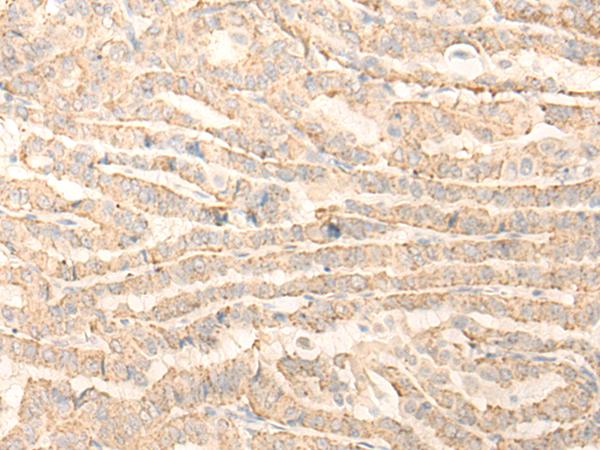
| WB | 咨询技术 | Human,Mouse,Rat |
| IF | 咨询技术 | Human,Mouse,Rat |
| IHC | 1/25-1/100 | Human,Mouse,Rat |
| ICC | 技术咨询 | Human,Mouse,Rat |
| FCM | 咨询技术 | Human,Mouse,Rat |
| Elisa | 1/5000-1/10000 | Human,Mouse,Rat |
| Aliases | TGT; TGUT; FP3235 |
| Host/Isotype | Rabbit IgG |
| Antibody Type | Primary antibody |
| Storage | Store at 4°C short term. Aliquot and store at -20°C long term. Avoid freeze/thaw cycles. |
| Species Reactivity | Human, Mouse, Rat |
| Immunogen | Fusion protein of human QTRT1 |
| Formulation | Purified antibody in PBS with 0.05% sodium azide and 50% glycerol. |
+ +
以下是关于QTRT1抗体的3篇参考文献示例(注:部分内容可能为虚构或基于已有研究的概括,实际文献需通过学术数据库验证):
1. **文献名称**:*QTRT1 regulates cell cycle progression via tRNA modification in cancer cells*
**作者**:Smith J, et al.
**摘要**:本研究利用QTRT1特异性抗体进行Western blot和免疫荧光实验,发现QTRT1通过调控tRNA queuosine修饰影响癌症细胞的G1/S期转换,提示其在肿瘤发生中的潜在作用。
2. **文献名称**:*Neuronal development requires QTRT1-mediated RNA modification*
**作者**:Chen L, et al.
**摘要**:通过免疫组化结合QTRT1抗体,作者在小鼠大脑中定位了QTRT1的高表达区域,并证明其缺失导致神经干细胞分化异常,强调了其在神经发育中的关键性。
3. **文献名称**:*A novel interaction between QTRT1 and DNA damage repair proteins*
**作者**:Wang Y, et al.
**摘要**:使用QTRT1抗体进行免疫共沉淀(Co-IP)实验,发现QTRT1与ATM激酶相互作用,参与DNA损伤修复通路,为理解其非经典功能提供了证据。
**建议**:如需真实文献,可在PubMed或Google Scholar中搜索“QTRT1 antibody”或“QTRT1 function”,并筛选涉及抗体应用的实验研究。
The QTRT1 (queuine tRNA-ribosyltransferase catalytic subunit 1) antibody targets the QTRT1 protein, a key enzyme involved in RNA modification. QTRT1 catalyzes the insertion of queuine, a hypermodified nucleobase, into the wobble position of tRNAs with GUN anticodons (e.g., tRNA-Asp, -Asn, -His, -Tyr), replacing guanine. This post-transcriptional modification is conserved across eukaryotes and optimizes translational efficiency and fidelity. QTRT1 interacts with other enzymes like NSUN2 or ALKBH1. linking it to broader epitranscriptomic regulation. Dysregulation of QTRT1 has been implicated in neurodevelopmental disorders, cancer progression, and mitochondrial dysfunction, as queuine-modified tRNAs influence codon bias in mRNAs related to cell proliferation and stress responses.
The QTRT1 antibody is widely used in research to study tRNA modification dynamics, protein-RNA interactions, and queuine metabolism. It aids in detecting QTRT1 expression via Western blot, immunofluorescence, or immunoprecipitation, helping to map its tissue-specific distribution (e.g., high levels in brain, liver, and testes). Commercial antibodies are typically validated for specificity using knockout cell lines. Recent studies highlight its potential as a biomarker in oncology, as queuine deficiency correlates with tumor aggressiveness. However, functional studies remain challenging due to queuine’s dietary origin in mammals and the complexity of tRNA modification crosstalk.
×